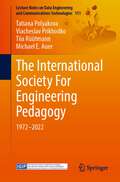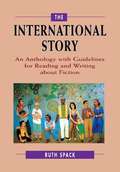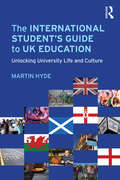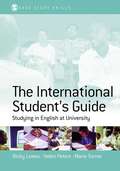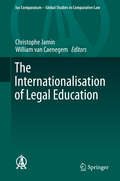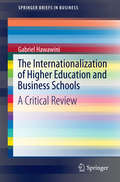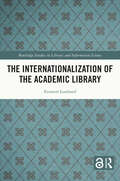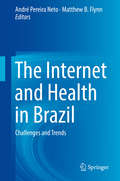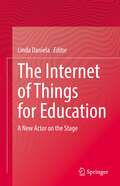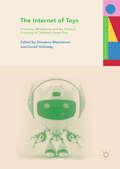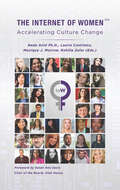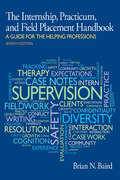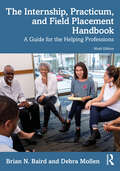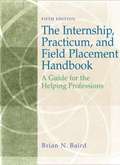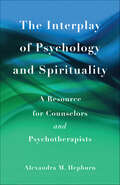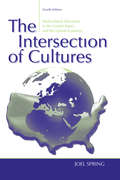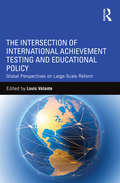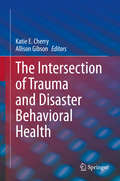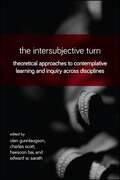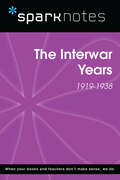- Table View
- List View
The International Society For Engineering Pedagogy: 1972–2022 (Lecture Notes on Data Engineering and Communications Technologies #151)
by Michael E. Auer Tiia Rüütmann Tatiana Polyakova Viacheslav PrikhodkoThis book is dedicated to the history and contemporary activities of IGIP that occupies a unique position among world organizations who are focused on Engineering Education. We are currently in the process of transforming education at all levels. This applies in particular to the professional and academic education and training of engineers.To face these current real-world challenges, higher education has to find innovative ways to quickly respond to these new needs. This and completely new technologies in education require specifically new and adapted approaches in Engineering Pedagogy.This book is a continuation of IGIP’s tradition to summarize and analyze intermediate results and foresee the main trends of further development of Engineering Pedagogy. It is written for the 50th anniversary of IGIP and contains valuable historic information as well as memories and opinions of IGIP members and specialists in Engineering Pedagogy.This book is intended for teachers at technical colleges and universities, students, post-graduates, administrative staff of educational institutions, staff of state educational ministries and committees, members of other societies with interest in Engineering Education, staff of personnel agencies, and everyone who is interested in Engineering Education and Pedagogy. Interested readership includes furthermore policymakers, academic researchers in pedagogy and learning theory, schoolteachers, the learning industry, further and continuing education lecturers, etc.
The International Story: An Anthology with Guidelines for Reading and Writing about Fiction
by Ruth SpackThe International Story is an anthology with guidelines for reading and writing about fiction.
The International Student's Guide to UK Education: Unlocking University Life and Culture
by Martin HydeAre you thinking of studying at university in Britain? Do you feel confused about which course is best for you, which university to choose, and how to apply? Are you wondering about what kinds of challenges you will be faced with, how best to approach them and how to overcome them? If so, this guidebook is for you. Honest and accurate, this book acts as an international student introduction and cultural guide to UK Higher Education. It informs and guides students in their preparation for all aspects of UK HE, from university selection and application through to participation, and provides a clear understanding of how British universities function. Helping international students make the most of the many opportunities that university offers, this text will expand your knowledge of UK Higher Education with regards to: Application procedures Finances Self-awareness, cultural understanding and adaptation (social and academic) University administrative procedures, facilities and support Work and career information and advice. The International Student’s Guide to UK Education is a comprehensive guide that will help students to develop critical and reflective ability in order to become independent, well-informed and empowered decision makers.
The International Student's Guide: Studying in English at University (SAGE Study Skills Series)
by Helen Peters Marie Stephenson Ricki LowesThis book is intended for students from all language backgrounds other than English, attending or preparing to attend a university where the medium of instruction is English, particularly in the UK. The International Student's Guide helps you succeed at university, by sharing the experiences of many international students who have already attended a university in the UK. Every student is unique, with different abilities and needs. With this in mind, the authors provide you with practical information and help on a range of aspects of study. They focus on both spoken and written forms of communication, and deal with the approaches to thinking and learning which you will meet in higher education in the UK system. Written by experienced lecturers in language and learning, the book offers a wealth of advice and guidance on topics such as: ways of learning how to make the most of your own strengths working in seminars and groups writing in different forms, disciplines and at different levels assessment techniques such as exams and oral presentations. Whether you are embarking on a pre-degree foundation course or a postgraduate programme, this book will help you manage all the challenging aspects of studying through the medium of another language, in a new and different environment. This book is for students studying at any level in English on Foundation courses, on degree programmes, undergraduate or postgraduate, or on pre-masters programmes. It could be used in EAP classes and on summer courses and pre-entry programmes or for self study. It could also be used for staff-development purposes with lecturers teaching students from different language backgrounds. It is assumed that the reader already has a grasp of English at least equivalent to IELTS 4.5 or 5 or TOEFL 450-500 (130-170 on the computerised test). SAGE Study Skills are essential study guides for students of all levels. From how to write great essays and succeeding at university, to writing your undergraduate dissertation and doing postgraduate research, SAGE Study Skills help you get the best from your time at university. Visit the SAGE Study Skills website for tips, quizzes and videos on study success!
The International Student's Survival Guide: How to Get the Most from Studying at a UK University
by Gareth DaveyThe International Student's Survival Guide is a comprehensive and easy-to-use guide to studying and living in the UK. It will be invaluable in preparing international students for the inevitable differences in culture, customs, and academic life, and helps to ensure they get the most out of their time at University. Gareth Davey provides students with all the information needed to make the right choice about where to study and provides valuable advice on how to settle into your new surroundings, including guidance on: Choosing and applying for a course Leaving home and arriving in the UK Managing finances and living costs Academic culture Teaching and assessment methods Health and welfare Life after graduationThroughout the guide there are checklists and self-evaluation forms to help the reader chart their progress. A glossary is included to aid understanding of the topics covered, and directories of additional sources of information make it easy to find out more where necessary. This guide will be a useful resource for students coming to the UK to embark on either undergraduate or graduate study in any subject.
The Internationalisation of Legal Education
by Christophe Jamin William Van CaenegemThis volume provides an overview of thestate of internationalisation of legal education (IOLE) in many civil law andcommon law countries. It provides a picture of the status of the debate aboutthe shape and degree of internationalisation in the curriculum in the differentcountries, and the debates surrounding the adoption of a more internationalapproach to legal education in the contemporary world. It is a compilation of the NationalReports submitted for the August 2014 Congress of the IACL held at Vienna, andcontains an introductory general report. Together, the reports examine suchquestions as: Why is the topic of internationalization of legal education on theagenda now? Why is it a relevant subject for examination today? Does the topic generatethe same level of interest everywhere in the world? Is enthusiasm for IOLEmainly driven by the academic sector, by government, by multinationalcorporations? Is the interest closely linked with the globalization of thepractice of law? Or is globalisation of law itself something of a myth, or areality reserved for only a very small percentage of practising lawyers aroundthe world? The general andnational reports make clear that there is indeed widespread interest in IOLE,and numerous disparate initiatives around the world. Nonetheless, some NationalReporters state that the topic is simply not on the agenda at all. All in all,the volume shows that the approachesto internationalisation are many and varied, but every jurisdiction recognisesthe importance of introducing aspiring lawyers to a more integrated globalenvironment.
The Internationalization of East Asian Higher Education: Globalization’s Impact (International and Development Education)
by John D. Palmer Amy Roberts Young Ha Cho Gregory S. ChingDevelops new and intriguing insights into globalization theory and internationalization practice, expanding the investigation of East Asian values and contexts in comparison and separate from Western-dominant thoughts of globalization and internationalization in higher education.
The Internationalization of Higher Education and Business Schools
by Gabriel HawawiniThis book provides a critical review of the internationalization process among higher education institutions (HEIs), taking a closer look at the case of business schools. The first part offers a novel definition of this phenomenon and examines the forces that drive international initiatives. It then examines and explains the "internationalization paradox": the observation that despite evidence that many international initiatives fail to deliver what they promise, for the heads of HEIs they nevertheless remain at the top of the agenda. In turn, the second part of the book develops a unifying framework that identifies alternative models of internationalization and explains how they relate to one another. Based on this framework, the book presents a model of the truly global HEI, whose mission is to learn from the world rather than teach the world what it knows. The book's central thesis is that it is unlikely that HEIs will be able to transform themselves into truly global HEIs because of historical and organizational barriers rather than a shortage of resources or a lack of visionary leadership. The book concludes that most HEIs should refrain from claiming that their aim is to become global institutions, and should instead focus on the successful implementation of an import-export model of internationalization that calls for initiatives such as the internationalization of the curriculum, the creation of student and faculty exchange programs, and the participation in international academic and research partnerships. Any attempt to transform themselves into truly global institutions is unlikely to succeed and may distract them from their fundamental mission: to educate their home-based students and help them become effective global citizens.
The Internationalization of the Academic Library (Routledge Studies in Library and Information Science)
by Emmett LombardThe Internationalization of the Academic Library presents a theoretically informed, empirically grounded analysis of the process of academic library internationalization. Drawing on interviews with library personnel from around the world, Lombard analyzes internationalization at the departmental level of an academic library. Demonstrating that college and library personnel have positive intentions when it comes to internationalization, the research presented nevertheless reveals that there was little commitment to an intentional, holistic role in the libraries studied. Drawing on internationalization expertise and models of prominent scholars, the book argues that libraries need to be more deliberate in their internationalization efforts and collaborate with other college personnel and departments outside the library. Lombard asserts that internationalization can facilitate a better understanding of the potential for transformation of the library’s mission, vision, and policy. This book cuts across the fields of library science and higher education administration, ensuring that the book will appeal to researchers and students working in these disciplines. Library professionals around the world will also find much to interest them within the book.
The Internationalization of the Academy
by Futao Huang Martin Finkelstein Michele RostanThis volume provides a nuanced empirical assessment of the extent to which the academic profession is internationalized at the beginning of the 21st century. It indicates which are the most internationalized academic activities, and focuses on specific topics such as physical mobility for study or professional purposes, teaching abroad or in another language, research collaboration with foreign colleagues, and publication and dissemination outside one's native country or in another language. It places the main theme in the wider context of the history of higher education's internationalization. It provides explanations on what drives and deters academics from international activity, and documents some of the consequences that internationalization has on academic work and productivity. This study is based on a survey of 25,000 academics working at higher education institutions in 18 countries and Hong Kong on five continents. Comparing data from the 1992 Carnegie International study to the 2007 CAP survey, relying on respondents' perceptions of change, and comparing different academic generations, it offers valuable insights on changes in the internationalization of the academy.
The Internet and Health in Brazil: Challenges and Trends
by André Pereira Neto Matthew B. FlynnThe popularization of the Internet, due in larger part to the advent of multifunctional cell phones, poses new challenges for health professionals, patients, and caregivers as well as creates new possibilities for all of us. This comprehensive volume analyzes how this social phenomenon is transforming long-established healthcare practices and perceptions in a country with one of the highest numbers of Internet users: Brazil. After an opening text that analyzes the Internet and E-Health Care as a field of study, the book comprises six parts. The first part introduces the emergence and development of the internet in Brazil, its pioneering experience in internet governance, digital inclusion, and online citizen participation. The second part is dedicated to internet health audiences by analyzing the cases of patients, the young, and the elderly seeking and sharing health information online, especially in virtual communities. The third part is dedicated to the challenges that the expansion of the internet in healthcare poses to all of us, such as the evaluation of the quality of health information available online and the prevention of the risks involved with online sales, cyberbullying, and consumption of prescription medicines. The fourth presents some innovative e-learning experiences carried out with different groups in Brazil, while the fifth part analyses some practical applications involving the Internet and health, including studies on M-Health, the Internet of things, serious games and the use of new information and communication technologies in health promotion. The last chapter analyses the future of healthcare in the Internet Age. The authors establish a critical and creative debate with international scholarship on the subject. This book is written in a direct and comprehensible way for professionals, researchers, students of communication and health, as well as for stakeholders and others interested in better understanding the trends and the different challenges related to the social phenomenon of the internet in health.
The Internet of Things for Education: A New Actor on the Stage
by Linda DanielaThis book is about the Internet of Things in the field of education. Specifically, it focuses on two major topics: IoT (Internet of Things) solutions to support distance education and new pedagogical approaches to support development of computational thinking with educational devices possessing the characteristics of IoT. As the educational landscape has dramatically changed in times of global pandemic, online resources and media, such as IoT, have become increasingly important. This situation compels all educational scholars, researchers and practitioners to search for new solutions, new educational pathways and new agents for knowledge development to support learning. This book presents the possibilities of IoT as both a catalyst and performance tool for education. The convergence of multiple technologies, real-time analytics, machine learning, commodity sensors, and embedded systems can serve as tools for learning support and this book details exactly how these powerful tools can be utilized to best effect.
The Internet of Toys: Practices, Affordances and the Political Economy of Children’s Smart Play (Studies in Childhood and Youth)
by Giovanna Mascheroni Donell HollowayThe Internet of Toys (IoToys) is a developing market within our Internet of Things (IoT) ecosystem. This book examines the rise of internet-connected toys and aims to anticipate the opportunities and risks of IoToys before their widespread diffusion. Contributors to this volume each provide a critical analysis of the design, production, regulation, representation and consumption of internet-connected toys. In order to address the theoretical, methodological and policy questions that arise from the study of these new playthings, and contextualise the diverse opportunities and challenges that IoToys pose to educators, families and children themselves, the chapters engage with notions of mediatization, datafication, robotification, connected and post-digital play. This timely engagement with a key transformation in children’s play will appeal to all readers interested in understanding the social uses and consequences of IoToys, and primarily to researchers and students in children and media, early childhood studies, media and communications, sociology, education, social psychology, law and design.
The Internet of Women - Accelerating Culture Change
by Nada Anid; Laurie Cantileno; Monique J. Morrow; Rahilla ZafarFemale scientists, technologists, engineers, and mathematicians worldwide are making historic contributions to their fields. The modern workforce is closer to gender-equal than it has ever been, and many efforts are in place to support further progress. The Internet of Women provides an exciting look at personal narratives and case studies of female leaders and cultural shifts around the globe that illustrate this promising trend. From the United Nations' emphasis on girls and technology education in the SDGs (Sustainable Development Goals) to the increased female labor force in Zambia, a policy change that was inspired by the MDGs (UN Millennial Development Goals), The Internet of Women captures stunning examples of progress from around the world and men working hand in hand with women advocating for cultural change. Scholars and practitioners lament the lack of women leading and working in leading organizations in the technology industry. Gender equality and female participation in the tech field is critical to both developing and developed economies; nevertheless, this gap remains a global phenomenon. The lack of female leadership is particularly extreme at the highest echelons of leading technology organizations. Few publicly traded tech companies have female CEOs - in fact, most nations have zero female leadership in the tech industry. This gap does indicate a slow pace of progress for gender equality in tech employment. Women's pay still lags nearly a decade behind, according to the World Economic Forum, meaning that women's on average pay today is the equivalent to that of similarly qualified and similarly employed men in 2006. Without significant progress, the current rate of change will not lead to parity for 118 years, according to the World Economic Forum (WEF). However there's significant work being done to shift this tide. Take for instance Michelle Lee, the first female Under Secretary of Commerce for Intellectual Property and Director of the United States Patent and Trademark Office (USPTO), reflects on her childhood Girl Scout badge in sewing and cooking and how that memory inspired to create an IP badge that exposes young women to the process of invention. Social entrepreneur, investor, and Malala Fund co-founder Shiza Shahid shares her efforts beginning from mentoring young women in Pakistan to her current work directing more investment to women innovators around the globe. And Elizabeth Isele, a senior fellow in Social Innovation at Babson College, shares her research on women and ageism saying we need to retire the word retirement. The book is divided into six parts, each with unique areas of focus:• Millennials Leading: Exploring Challenges and Opportunities Facing the Next Generation of Women in Technology• Men and Women Empowering One Another• Bold Leadership: Women Changing the Culture of Investment and Entrepreneurship• Educating for the 21st Century• Breaking the Glass Ceiling: A Generation of Women Forging into Technology Leadership• Emerging Fields of TechnologyThe Internet of Women gathers examples about the increasingly inclusive and progressive gender culture in technology from over 30 countries. Stories range from an entrepreneur in Dubai partnering with private and public sector entities to accelerate blockchain technology to a young British woman moving to Silicon Valley to launch an artificial intelligence platform and incubator. The book is intended for corporations, academic institutions, the private sector, government agencies, gender experts, and the general public, and its key benefit is to let the reader understand a path towards implementing diversity overall globally. It also showcases the strategies, tools, and tactical execution on how create cultural change in all parts of the world.
The Internship, Practicum, and Field Placement Handbook
by Brian N. BairdThe Internship, Practicum, and Field Placement Handbook, Seventh Edition is a practical guide to the real world knowledge and skills that students need when they begin working in the field of mental health. This text guides interns through every phase of the internship process from finding placements to concluding relationships with clients and supervisors. Along the way students learn about ethics, clinical writing and record keeping, working with peers and supervisors, understanding diversity, and self care and safety. Following an evidence and competency based approach, the latest research findings are reviewed from the fields of psychology, social work and counseling. "
The Internship, Practicum, and Field Placement Handbook: A Guide for the Helping Professions
by Brian N. Baird Debra MollenThe Internship, Practicum, and Field Placement Handbook offers real-world knowledge of the skills interns in the helping professions need through every phase of their internship, practicum, or field placement. The focus is on topics that may not have been addressed or fully developed through regular academic coursework: meeting clients, fees for service, supervision, ethics, legal issues, diversity, clinical writing, case notes and clinical records, personal safety, self-care, advocacy, technology, termination, and planning for the future. Every phase of the internship is discussed sequentially, from finding and preparing for placements to concluding relationships with clients and supervisors. Drawing from the fields of psychology, counseling, social work, school counseling, and psychiatry, this edition has been thoroughly updated with the latest research and clinical literature, ethical codes of the leading professions, and legal and regulatory developments at federal and state levels. This edition also features up-to-date coverage of remote education, training, supervision, and practice as impacted by Covid-19 and technological changes. Diversity awareness and insights are woven through every element of the text, taking into account recent developments such as Black Lives Matter, the MeToo movement, gender identity awareness. Other emerging issues are also addressed, including the impact of the opioid epidemic and substance abuse deaths and the ethical/legal issues that may arise relating to reproductive health and abortion related legislation. In-text exercises and thought problems are incorporated into each chapter for students to develop insights and skills. Eleven online appendices are also included, containing learning plans, supervision agreements, evaluation forms, and ethical guidelines that students will need in preparation for the next phase of their training. The Internship, Practicum, and Field Placement Handbook is an invaluable resource for students, faculty, and supervisors engaged in the challenging experience of transitioning from academia into clinical training in the field.
The Internship, Practicum, and Field Placement Handbook: A Guide for the Helping Professions (3rd edition)
by Brian N. BairdStudents, instructors, and field supervisors in the helping professions can use this book as a resource on performing responsibly and safely in field placements. Ethical and legal principles, record keeping, report writing, supervision, diversity, and dealing with dangerous clients are covered in detail in an accessible style. Appendices provide forms for field learning agreements, evaluation, and informed consent. This third edition adds new exercises and incorporates new discussions of managed care, student portfolios, and career planning.
The Interplay of Psychology and Spirituality: A Resource for Counselors and Psychotherapists
by Alexandra M. HepburnMany counseling clients find comfort and meaning in their spiritual lives, in the context of religious affiliation or the diverse viewpoints of the “spiritual but not religious.” But counselors and psychotherapists often lack training for work in this territory and may be wary of opening the door. The Interplay of Psychology and Spirituality is an exploration of the subtle, fluid relationship between psychology and spirituality that offers valuable perspectives and suggestions for embracing spirituality and religion in the helping professions. Drawing on Jungian, transpersonal, and integral perspectives, Hepburn highlights personal and cultural styles, spirituality as a therapeutic resource, and the potential for psychospiritual growth. She also emphasizes the importance of focusing on metaphors, stories, and direct experience rather than beliefs. Thoughtful attention is given to potential psychospiritual problems, ethical dilemmas, and diagnostic challenges. There are also frequent opportunities for personal reflection. Unique features of the book include consideration of the potential relationship of spirituality to therapeutic themes such as attachment, trauma, subpersonalities, and somatic experience, as well as application of the concepts in the stories of nine fictional characters based on the Enneagram. Thoughtful and thought provoking, The Interplay of Psychology and Spirituality is a valuable resource for helping professionals, spiritual directors, and for general readers with a particular interest in the subject.
The Interruption of Heteronormativity in Higher Education: Critical Queer Pedagogies (Queer Studies and Education)
by Michael SealThis book examines how heteronormativity in higher education can be interrupted and resisted. Located within the theoretical framework of queer and critical pedagogy and based on extensive empirical research, the author explores the dynamics of heteronormativity and its interruption on professional courses in a range of higher education institutions. Reactions to attempt to interrupt it were nuanced: while strategies of contested engagement, avoidance and retreat were expressed, heterosexualities were largely un-examined and un-articulated. ‘Coming out’ needs to be a pedagogical act, carried out concurrently with the interruptions of other social constructions and binary oppositions. The author calls for co-created and co-held meta-reflexive and liminal spaces that emphasise inter-subjectivity, encounters, and working in the moment. These spaces must de-construct and reconstruct pedagogical power and knowledge to promote collective intersubjective consciousnesses, and widen the vision of the reflective practitioner to that of the pedagogical practitioner. This pioneering book is a call to action to all those concerned with interrupting and problematising presumed binary categories of sexuality within the heterosexual matrix.
The Intersection of Cultures: Multicultural Education in the United States and the Global Economy (Sociocultural, Political, and Historical Studies in Education)
by Joel SpringThe Intersection of Cultures: Multicultural Education in the United States and the Global Economy, Fourth Edition offers a unique, problem-solving approach to the complex issues involved in educating culturally and linguistically diverse students. Perfect for any course devoted wholly or in part to the study of multicultural education, this text addresses a wealth of topics. A particular focus in this edition is the current global migration of peoples, and the tension between local and global cultures. Part One, Multiculturalism, includes chapters on cultural differences and schooling, dominated cultures, and immigrant cultures. Chapters in Part Two, Cultural Frames of Reference, address monoculturalism, biculturalism, and ethnic identity; multicultural minds; history, gender, and social class; and the intersection of school culture with dominated and immigrant cultures. Part Three, Perspectives on Teaching Multicultural Education, includes chapters on teaching about racism; teaching about sexism; and teaching to protect and preserve cultures. All chapters include model multicultural lessons for elementary through college classes. These lessons serve a dual function—first, they can be used to help teach the content of the chapter, and second, elementary, middle school, and high school teachers can use these lessons in their own classes. Each chapter concludes with a “Personal Frames of References” section designed to engage students in relating multiculturalism to their own lives. New in the Fourth Edition: *cultural differences in ways of seeing, knowing, and interrelating with the world;*recent research findings from cross cultural psychology and the psychology of immigration; and*methods for educating “multicultural minds”.
The Intersection of International Achievement Testing and Educational Policy: Global Perspectives on Large-Scale Reform
by Louis VolanteEducational systems around the world look to student assessment programs as they initiate reforms and revise educational policies to increase student achievement. This edited volume examines the intersection of international achievement testing and education policy development in key countries around the world, exploring how assessments can inform curriculum, pedagogy, strategic planning, and ultimately determine large-scale education policy and governance. Noted chapter contributors explore how educational leadership and governance issues have been influenced by assessment programs across a range of political, economic, cultural, and educational contexts. The Intersection of International Achievement Testing and Education Policy provides educators, academics, and policymakers with cultural insights, historical contexts, and a framework for negotiating and understanding the consequences of educational policy decisions in schools.
The Intersection of Trauma and Disaster Behavioral Health
by Katie E. Cherry Allison GibsonThis contributed volume examines the intersection of trauma and disaster behavioral health from a lifespan perspective, filling a critical gap in the literature on disaster mental health research. In the chapters, the contributors evaluate behavioral data of adults exposed to various environmental events in both the United States (i.e., the 2017 Hurricanes Irma in Florida and Harvey in Houston) and abroad (i.e., missile fire in the 2014 Israel-Gaza conflict). Contributors also suggest future directions, practices, and policies for trauma and disaster response. The three parts of the book provide an overview of disaster behavioral health across the lifespan, propose practical applications of research theories to psychosocial problems resulting from disasters and trauma, and evaluate disaster and trauma interventions from a macro-level perspective. Topics explored among the chapters include:Integrating Trauma-Informed Principles into Disaster Behavioral Health Targeting Older Adults Cultural Competence and Disaster Mental Health When Disasters Strike: Navigating the Challenges of “Sudden Science” Frameworks of Recovery: Health Caught at the Intersection of Housing, Education, and Employment Opportunities After Hurricane Katrina Substance Use Issues and Behavioral Health After a Disaster Psychosocial Recovery After Natural Disaster: International Advocacy, Policy, and RecommendationsThe Intersection of Trauma and Disaster Behavioral Health is a vital resource for researchers whose expertise covers the domains of trauma, health and wellness, and natural and technological disasters. The book also is a useful supplement to graduate courses in psychology, sociology, social work, disaster science, human ecology, and public health.
The Intersubjective Turn: Theoretical Approaches to Contemplative Learning and Inquiry across Disciplines
by Olen Gunnlaugson; Charles Scott; Heesoon Bai; Edward W. SarathA first of its kind, this book maps out current academic approaches in higher education to second-person contemplative education, which addresses contemplative experience from an intersubjective perspective. Until recently, contemplative studies has emphasized a predominantly first-person standpoint, but the expansion and embrace of second-person methods provides a distinctive learning context in which collective wisdom and shared learning can begin to emerge from dialogue among students and groups in the classroom. The contributors to this volume, leading researchers and practitioners from a variety of institutions and departments, examine the theoretical and philosophical foundations of second-person contemplative approaches to instruction, pedagogy, and curricula across various scholarly disciplines.
The Interwar Years (SparkNotes History Notes)
by SparkNotesThe Interwar Years (1919-1938) (SparkNotes History Note) Making the reading experience fun! SparkNotes History Guides help students strengthen their grasp of history by focusing on individual eras or episodes in U.S. or world history. Breaking history up into digestible lessons, the History Guides make it easier for students to see how events, figures, movements, and trends interrelate. SparkNotes History Guides are perfect for high school and college history classes, for students studying for History AP Test or SAT Subject Tests, and simply as general reference tools.Each note contains a general overview of historical context, a concise summary of events, lists of key people and terms, in-depth summary and analysis with timelines, study questions and suggested essay topics, and a 50-question review quiz.
The Intimate University: Korean American Students and the Problems of Segregation
by Nancy AbelmannThe majority of the 30,000-plus undergraduates at the University of Illinois, Urbana-Champaign--including the large population of Korean American students--come from nearby metropolitan Chicago. Among the campus's largest non-white ethnicities, Korean American students arrive at college hoping to realize the liberal ideals of the modern American university, in which individuals can exit their comfort zones to realize their full potential regardless of race, nation, or religion. However, these ideals are compromised by their experiences of racial segregation and stereotypes, including images of instrumental striving that set Asian Americans apart. In The Intimate University, Nancy Abelmann explores the tensions between liberal ideals and the particularities of race, family, and community in the contemporary university. Drawing on ten years of ethnographic research with Korean American students at the University of Illinois and closely following multiple generations of a single extended Korean American family in the Chicago metropolitan area, Abelmann investigates the complexity of racial politics at the American university today. Racially hyper-visible and invisible, Korean American students face particular challenges as they try to realize their college dreams against the subtle, day-to-day workings of race. They frequently encounter the accusation of racial self-segregation--a charge accentuated by the fact that many attend the same Evangelical Protestant church--even as they express the desire to distinguish themselves from their families and other Korean Americans. Abelmann concludes by examining the current state of the university, reflecting on how better to achieve the university's liberal ideals despite its paradoxical celebration of diversity and relative silence on race.
